Daniel tried to sexually assault the victim even though she had resisted
VerifiedAdded on 2022/10/18
|12
|2865
|411
AI Summary
New South Wales (NSW): As (New South Wales) - s 61I, Sexual Assault means: Any individual who does sexual intercourse with another individual without the another person’s approval and who understands that the another individual does not submit to sexual intercourse is responsible to incarceration for 14 years. For constituting a case under the provisions of sexual assault few elements are required to be established by the prosecutor, which are as follows: Physical elements; (i) sexual intercourse,
Contribute Materials
Your contribution can guide someone’s learning journey. Share your
documents today.
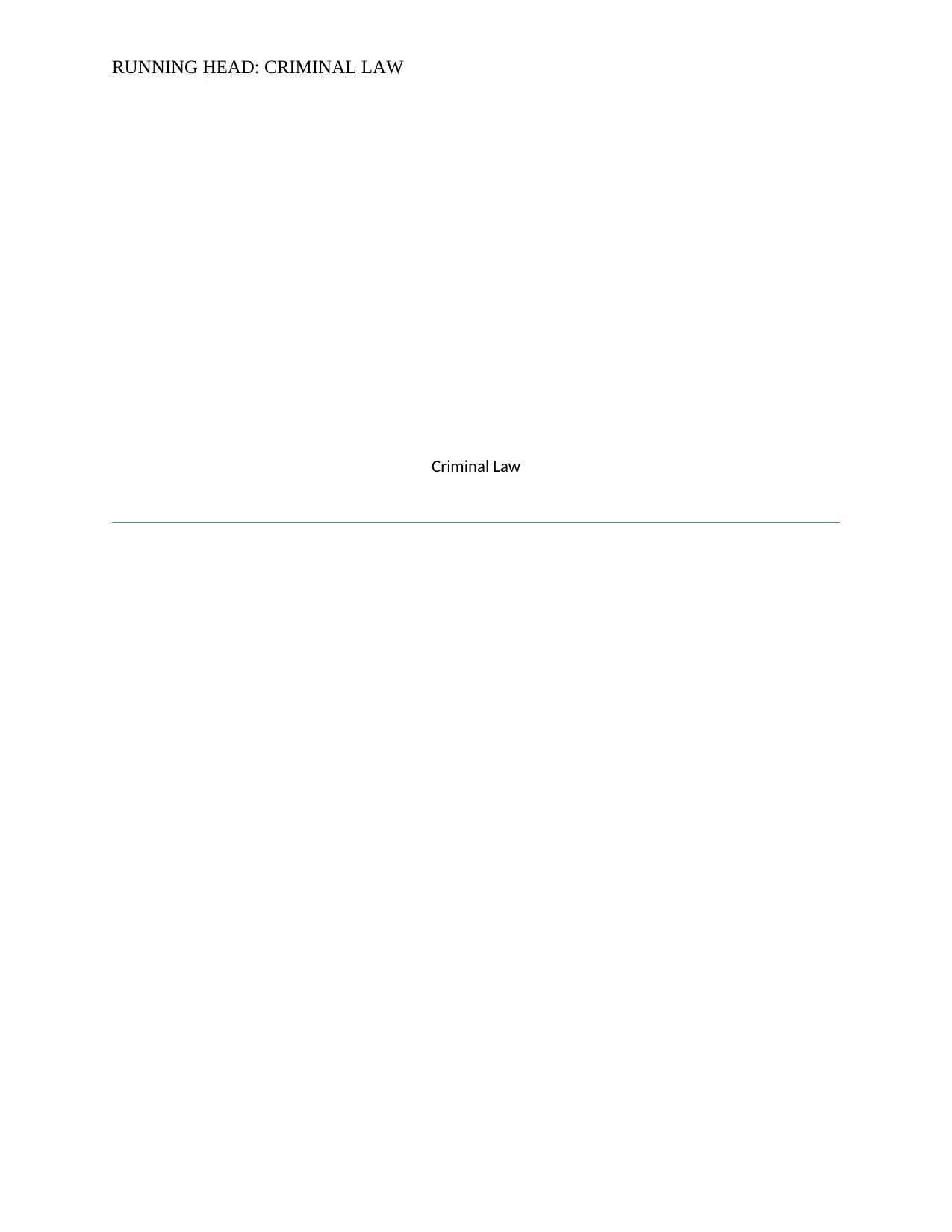
RUNNING HEAD: CRIMINAL LAW
Criminal Law
Criminal Law
Secure Best Marks with AI Grader
Need help grading? Try our AI Grader for instant feedback on your assignments.
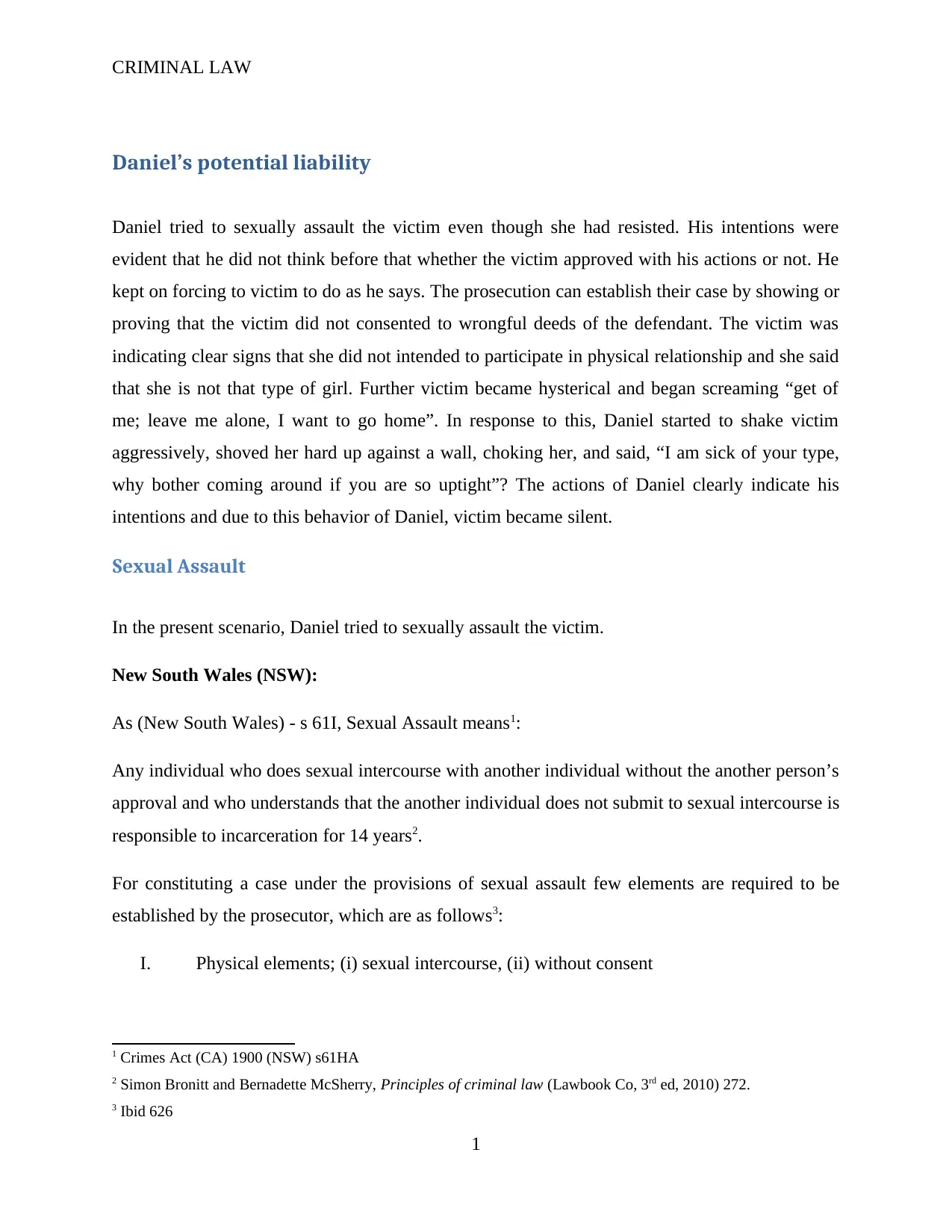
CRIMINAL LAW
Daniel’s potential liability
Daniel tried to sexually assault the victim even though she had resisted. His intentions were
evident that he did not think before that whether the victim approved with his actions or not. He
kept on forcing to victim to do as he says. The prosecution can establish their case by showing or
proving that the victim did not consented to wrongful deeds of the defendant. The victim was
indicating clear signs that she did not intended to participate in physical relationship and she said
that she is not that type of girl. Further victim became hysterical and began screaming “get of
me; leave me alone, I want to go home”. In response to this, Daniel started to shake victim
aggressively, shoved her hard up against a wall, choking her, and said, “I am sick of your type,
why bother coming around if you are so uptight”? The actions of Daniel clearly indicate his
intentions and due to this behavior of Daniel, victim became silent.
Sexual Assault
In the present scenario, Daniel tried to sexually assault the victim.
New South Wales (NSW):
As (New South Wales) - s 61I, Sexual Assault means1:
Any individual who does sexual intercourse with another individual without the another person’s
approval and who understands that the another individual does not submit to sexual intercourse is
responsible to incarceration for 14 years2.
For constituting a case under the provisions of sexual assault few elements are required to be
established by the prosecutor, which are as follows3:
I. Physical elements; (i) sexual intercourse, (ii) without consent
1 Crimes Act (CA) 1900 (NSW) s61HA
2 Simon Bronitt and Bernadette McSherry, Principles of criminal law (Lawbook Co, 3rd ed, 2010) 272.
3 Ibid 626
1
Daniel’s potential liability
Daniel tried to sexually assault the victim even though she had resisted. His intentions were
evident that he did not think before that whether the victim approved with his actions or not. He
kept on forcing to victim to do as he says. The prosecution can establish their case by showing or
proving that the victim did not consented to wrongful deeds of the defendant. The victim was
indicating clear signs that she did not intended to participate in physical relationship and she said
that she is not that type of girl. Further victim became hysterical and began screaming “get of
me; leave me alone, I want to go home”. In response to this, Daniel started to shake victim
aggressively, shoved her hard up against a wall, choking her, and said, “I am sick of your type,
why bother coming around if you are so uptight”? The actions of Daniel clearly indicate his
intentions and due to this behavior of Daniel, victim became silent.
Sexual Assault
In the present scenario, Daniel tried to sexually assault the victim.
New South Wales (NSW):
As (New South Wales) - s 61I, Sexual Assault means1:
Any individual who does sexual intercourse with another individual without the another person’s
approval and who understands that the another individual does not submit to sexual intercourse is
responsible to incarceration for 14 years2.
For constituting a case under the provisions of sexual assault few elements are required to be
established by the prosecutor, which are as follows3:
I. Physical elements; (i) sexual intercourse, (ii) without consent
1 Crimes Act (CA) 1900 (NSW) s61HA
2 Simon Bronitt and Bernadette McSherry, Principles of criminal law (Lawbook Co, 3rd ed, 2010) 272.
3 Ibid 626
1
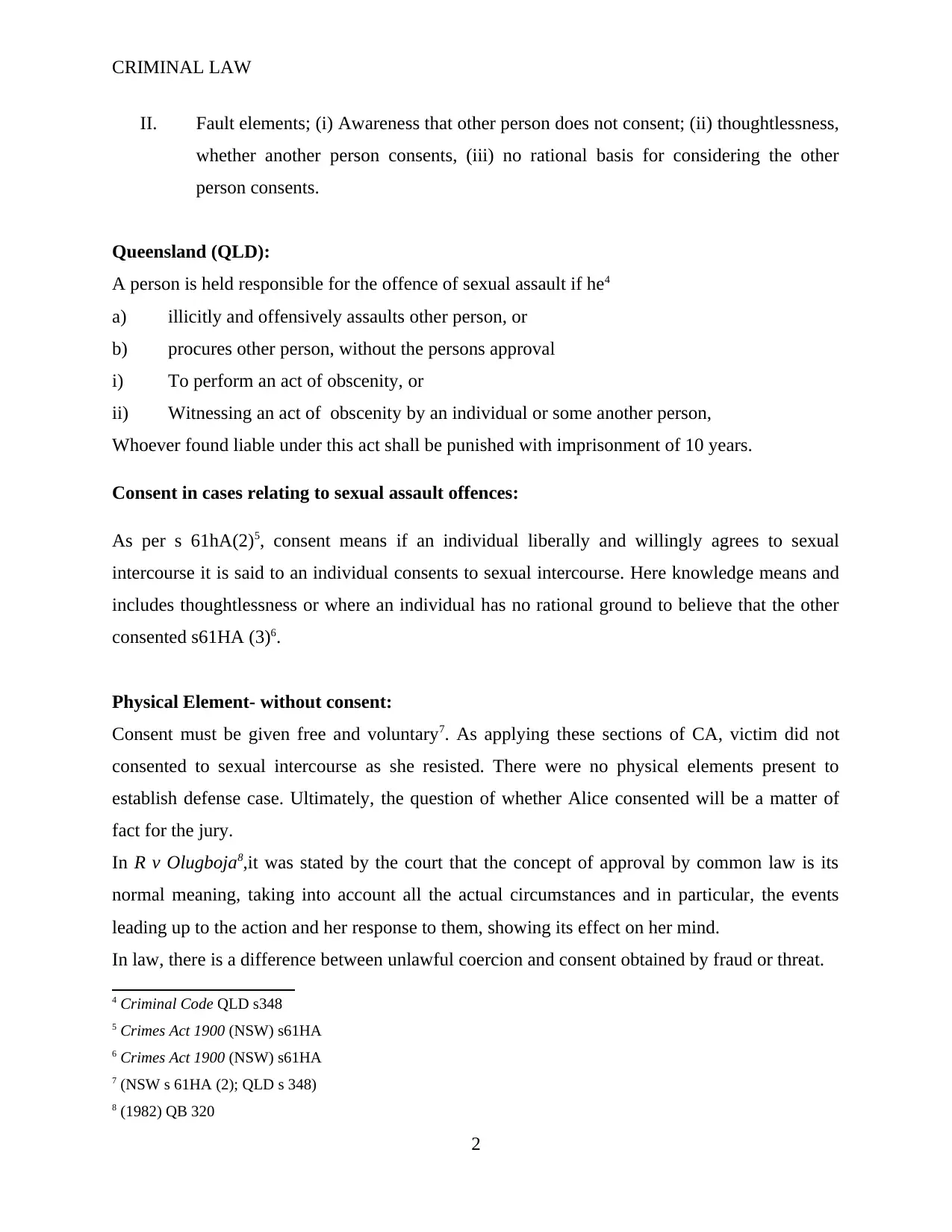
CRIMINAL LAW
II. Fault elements; (i) Awareness that other person does not consent; (ii) thoughtlessness,
whether another person consents, (iii) no rational basis for considering the other
person consents.
Queensland (QLD):
A person is held responsible for the offence of sexual assault if he4
a) illicitly and offensively assaults other person, or
b) procures other person, without the persons approval
i) To perform an act of obscenity, or
ii) Witnessing an act of obscenity by an individual or some another person,
Whoever found liable under this act shall be punished with imprisonment of 10 years.
Consent in cases relating to sexual assault offences:
As per s 61hA(2)5, consent means if an individual liberally and willingly agrees to sexual
intercourse it is said to an individual consents to sexual intercourse. Here knowledge means and
includes thoughtlessness or where an individual has no rational ground to believe that the other
consented s61HA (3)6.
Physical Element- without consent:
Consent must be given free and voluntary7. As applying these sections of CA, victim did not
consented to sexual intercourse as she resisted. There were no physical elements present to
establish defense case. Ultimately, the question of whether Alice consented will be a matter of
fact for the jury.
In R v Olugboja8,it was stated by the court that the concept of approval by common law is its
normal meaning, taking into account all the actual circumstances and in particular, the events
leading up to the action and her response to them, showing its effect on her mind.
In law, there is a difference between unlawful coercion and consent obtained by fraud or threat.
4 Criminal Code QLD s348
5 Crimes Act 1900 (NSW) s61HA
6 Crimes Act 1900 (NSW) s61HA
7 (NSW s 61HA (2); QLD s 348)
8 (1982) QB 320
2
II. Fault elements; (i) Awareness that other person does not consent; (ii) thoughtlessness,
whether another person consents, (iii) no rational basis for considering the other
person consents.
Queensland (QLD):
A person is held responsible for the offence of sexual assault if he4
a) illicitly and offensively assaults other person, or
b) procures other person, without the persons approval
i) To perform an act of obscenity, or
ii) Witnessing an act of obscenity by an individual or some another person,
Whoever found liable under this act shall be punished with imprisonment of 10 years.
Consent in cases relating to sexual assault offences:
As per s 61hA(2)5, consent means if an individual liberally and willingly agrees to sexual
intercourse it is said to an individual consents to sexual intercourse. Here knowledge means and
includes thoughtlessness or where an individual has no rational ground to believe that the other
consented s61HA (3)6.
Physical Element- without consent:
Consent must be given free and voluntary7. As applying these sections of CA, victim did not
consented to sexual intercourse as she resisted. There were no physical elements present to
establish defense case. Ultimately, the question of whether Alice consented will be a matter of
fact for the jury.
In R v Olugboja8,it was stated by the court that the concept of approval by common law is its
normal meaning, taking into account all the actual circumstances and in particular, the events
leading up to the action and her response to them, showing its effect on her mind.
In law, there is a difference between unlawful coercion and consent obtained by fraud or threat.
4 Criminal Code QLD s348
5 Crimes Act 1900 (NSW) s61HA
6 Crimes Act 1900 (NSW) s61HA
7 (NSW s 61HA (2); QLD s 348)
8 (1982) QB 320
2
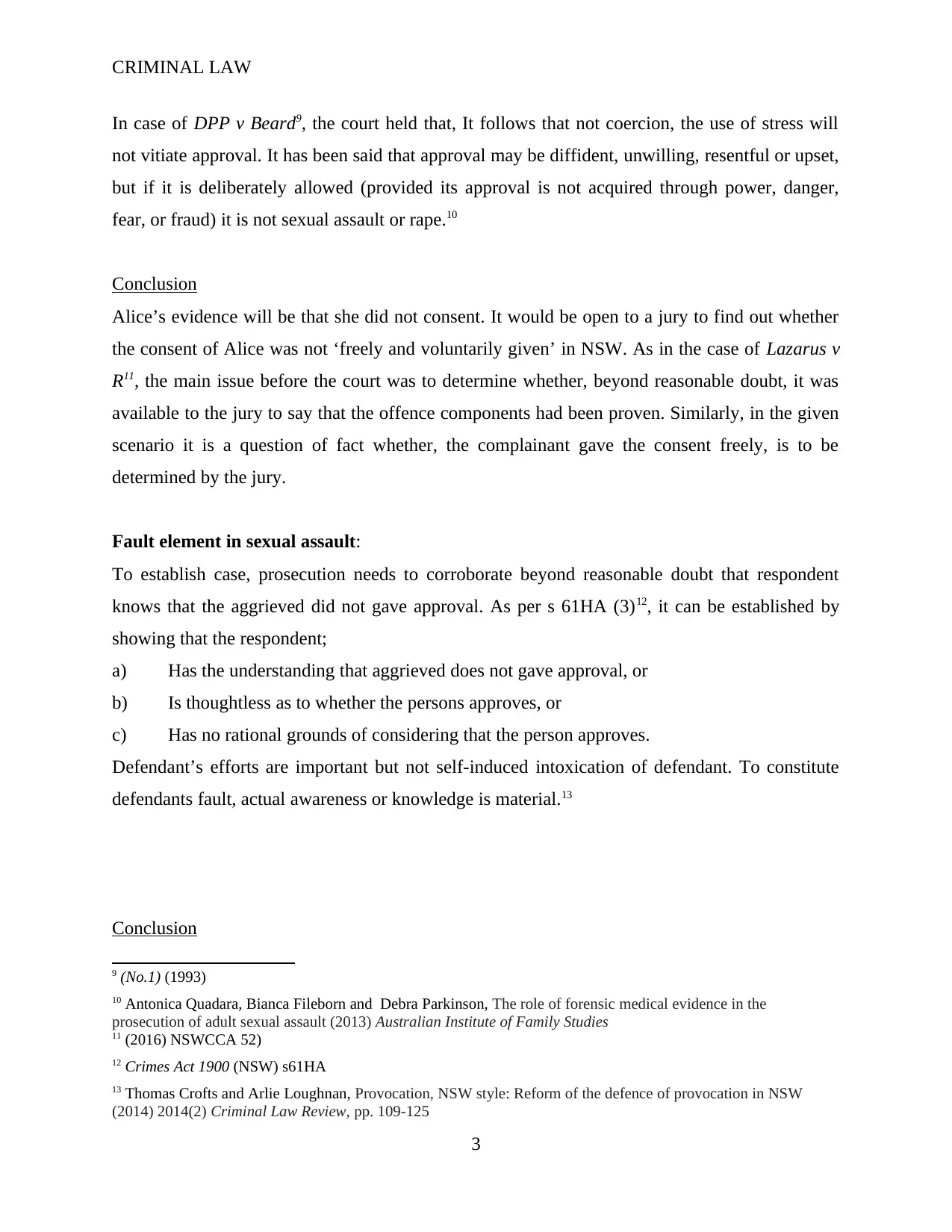
CRIMINAL LAW
In case of DPP v Beard9, the court held that, It follows that not coercion, the use of stress will
not vitiate approval. It has been said that approval may be diffident, unwilling, resentful or upset,
but if it is deliberately allowed (provided its approval is not acquired through power, danger,
fear, or fraud) it is not sexual assault or rape.10
Conclusion
Alice’s evidence will be that she did not consent. It would be open to a jury to find out whether
the consent of Alice was not ‘freely and voluntarily given’ in NSW. As in the case of Lazarus v
R11, the main issue before the court was to determine whether, beyond reasonable doubt, it was
available to the jury to say that the offence components had been proven. Similarly, in the given
scenario it is a question of fact whether, the complainant gave the consent freely, is to be
determined by the jury.
Fault element in sexual assault:
To establish case, prosecution needs to corroborate beyond reasonable doubt that respondent
knows that the aggrieved did not gave approval. As per s 61HA (3)12, it can be established by
showing that the respondent;
a) Has the understanding that aggrieved does not gave approval, or
b) Is thoughtless as to whether the persons approves, or
c) Has no rational grounds of considering that the person approves.
Defendant’s efforts are important but not self-induced intoxication of defendant. To constitute
defendants fault, actual awareness or knowledge is material.13
Conclusion
9 (No.1) (1993)
10 Antonica Quadara, Bianca Fileborn and Debra Parkinson, The role of forensic medical evidence in the
prosecution of adult sexual assault (2013) Australian Institute of Family Studies
11 (2016) NSWCCA 52)
12 Crimes Act 1900 (NSW) s61HA
13 Thomas Crofts and Arlie Loughnan, Provocation, NSW style: Reform of the defence of provocation in NSW
(2014) 2014(2) Criminal Law Review, pp. 109-125
3
In case of DPP v Beard9, the court held that, It follows that not coercion, the use of stress will
not vitiate approval. It has been said that approval may be diffident, unwilling, resentful or upset,
but if it is deliberately allowed (provided its approval is not acquired through power, danger,
fear, or fraud) it is not sexual assault or rape.10
Conclusion
Alice’s evidence will be that she did not consent. It would be open to a jury to find out whether
the consent of Alice was not ‘freely and voluntarily given’ in NSW. As in the case of Lazarus v
R11, the main issue before the court was to determine whether, beyond reasonable doubt, it was
available to the jury to say that the offence components had been proven. Similarly, in the given
scenario it is a question of fact whether, the complainant gave the consent freely, is to be
determined by the jury.
Fault element in sexual assault:
To establish case, prosecution needs to corroborate beyond reasonable doubt that respondent
knows that the aggrieved did not gave approval. As per s 61HA (3)12, it can be established by
showing that the respondent;
a) Has the understanding that aggrieved does not gave approval, or
b) Is thoughtless as to whether the persons approves, or
c) Has no rational grounds of considering that the person approves.
Defendant’s efforts are important but not self-induced intoxication of defendant. To constitute
defendants fault, actual awareness or knowledge is material.13
Conclusion
9 (No.1) (1993)
10 Antonica Quadara, Bianca Fileborn and Debra Parkinson, The role of forensic medical evidence in the
prosecution of adult sexual assault (2013) Australian Institute of Family Studies
11 (2016) NSWCCA 52)
12 Crimes Act 1900 (NSW) s61HA
13 Thomas Crofts and Arlie Loughnan, Provocation, NSW style: Reform of the defence of provocation in NSW
(2014) 2014(2) Criminal Law Review, pp. 109-125
3
Secure Best Marks with AI Grader
Need help grading? Try our AI Grader for instant feedback on your assignments.
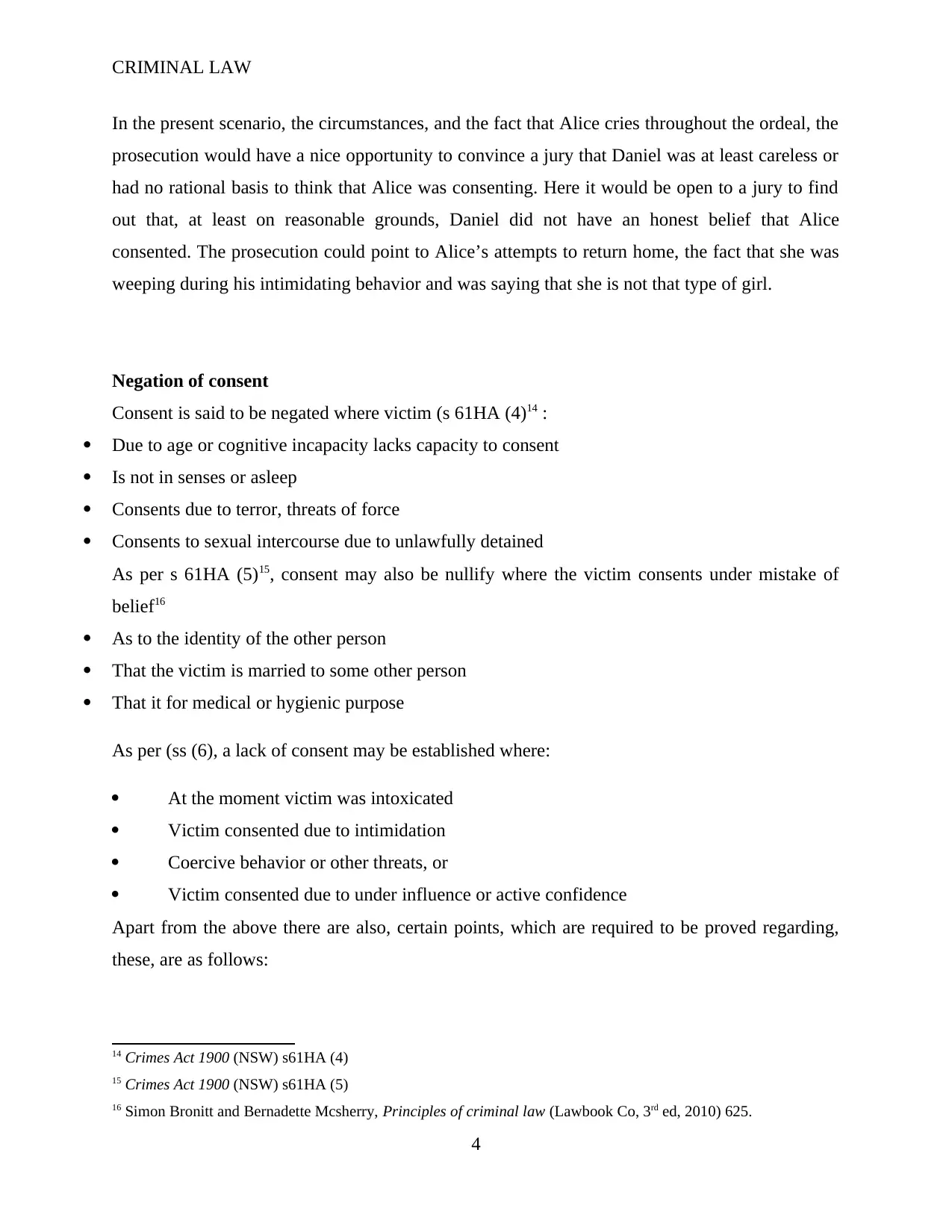
CRIMINAL LAW
In the present scenario, the circumstances, and the fact that Alice cries throughout the ordeal, the
prosecution would have a nice opportunity to convince a jury that Daniel was at least careless or
had no rational basis to think that Alice was consenting. Here it would be open to a jury to find
out that, at least on reasonable grounds, Daniel did not have an honest belief that Alice
consented. The prosecution could point to Alice’s attempts to return home, the fact that she was
weeping during his intimidating behavior and was saying that she is not that type of girl.
Negation of consent
Consent is said to be negated where victim (s 61HA (4)14 :
Due to age or cognitive incapacity lacks capacity to consent
Is not in senses or asleep
Consents due to terror, threats of force
Consents to sexual intercourse due to unlawfully detained
As per s 61HA (5)15, consent may also be nullify where the victim consents under mistake of
belief16
As to the identity of the other person
That the victim is married to some other person
That it for medical or hygienic purpose
As per (ss (6), a lack of consent may be established where:
At the moment victim was intoxicated
Victim consented due to intimidation
Coercive behavior or other threats, or
Victim consented due to under influence or active confidence
Apart from the above there are also, certain points, which are required to be proved regarding,
these, are as follows:
14 Crimes Act 1900 (NSW) s61HA (4)
15 Crimes Act 1900 (NSW) s61HA (5)
16 Simon Bronitt and Bernadette Mcsherry, Principles of criminal law (Lawbook Co, 3rd ed, 2010) 625.
4
In the present scenario, the circumstances, and the fact that Alice cries throughout the ordeal, the
prosecution would have a nice opportunity to convince a jury that Daniel was at least careless or
had no rational basis to think that Alice was consenting. Here it would be open to a jury to find
out that, at least on reasonable grounds, Daniel did not have an honest belief that Alice
consented. The prosecution could point to Alice’s attempts to return home, the fact that she was
weeping during his intimidating behavior and was saying that she is not that type of girl.
Negation of consent
Consent is said to be negated where victim (s 61HA (4)14 :
Due to age or cognitive incapacity lacks capacity to consent
Is not in senses or asleep
Consents due to terror, threats of force
Consents to sexual intercourse due to unlawfully detained
As per s 61HA (5)15, consent may also be nullify where the victim consents under mistake of
belief16
As to the identity of the other person
That the victim is married to some other person
That it for medical or hygienic purpose
As per (ss (6), a lack of consent may be established where:
At the moment victim was intoxicated
Victim consented due to intimidation
Coercive behavior or other threats, or
Victim consented due to under influence or active confidence
Apart from the above there are also, certain points, which are required to be proved regarding,
these, are as follows:
14 Crimes Act 1900 (NSW) s61HA (4)
15 Crimes Act 1900 (NSW) s61HA (5)
16 Simon Bronitt and Bernadette Mcsherry, Principles of criminal law (Lawbook Co, 3rd ed, 2010) 625.
4
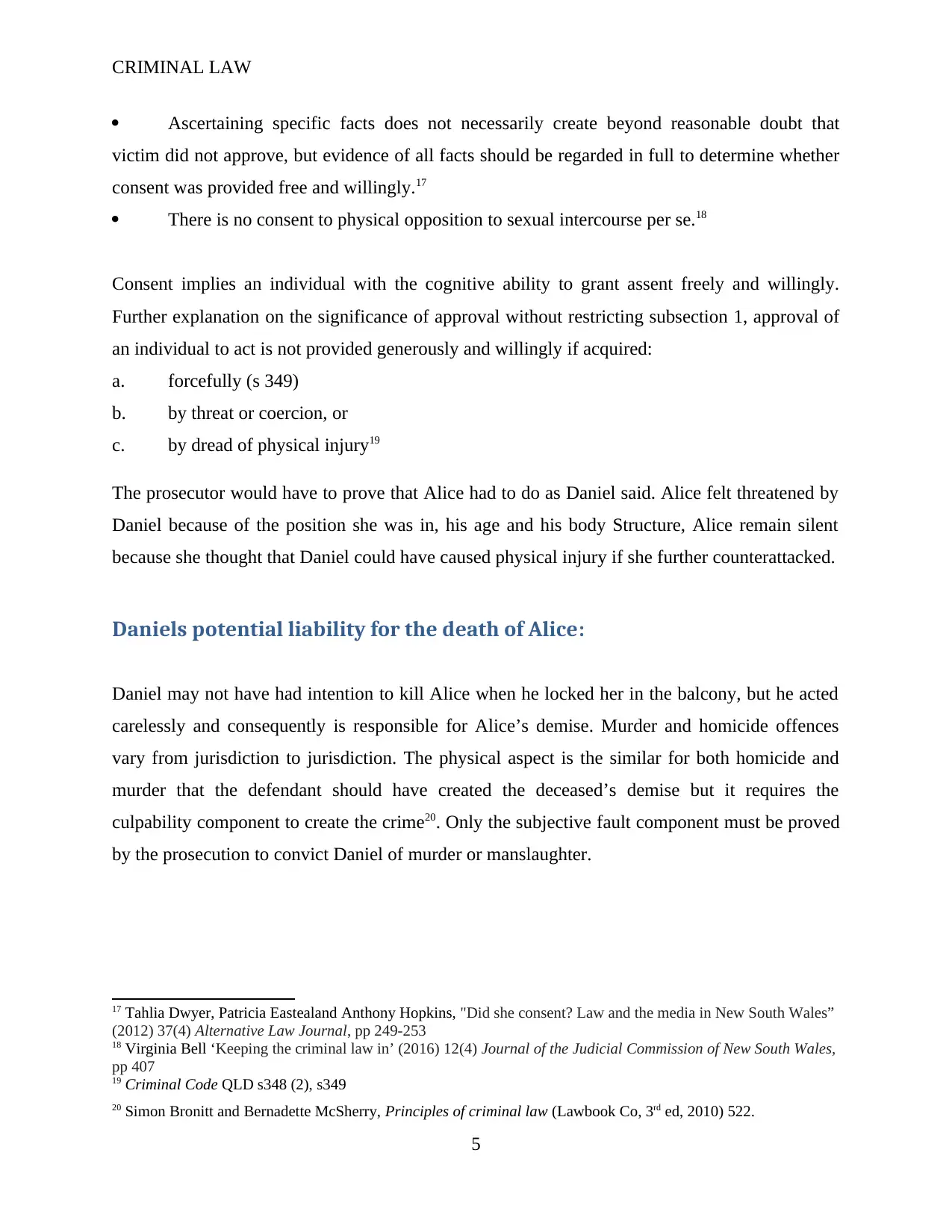
CRIMINAL LAW
Ascertaining specific facts does not necessarily create beyond reasonable doubt that
victim did not approve, but evidence of all facts should be regarded in full to determine whether
consent was provided free and willingly.17
There is no consent to physical opposition to sexual intercourse per se.18
Consent implies an individual with the cognitive ability to grant assent freely and willingly.
Further explanation on the significance of approval without restricting subsection 1, approval of
an individual to act is not provided generously and willingly if acquired:
a. forcefully (s 349)
b. by threat or coercion, or
c. by dread of physical injury19
The prosecutor would have to prove that Alice had to do as Daniel said. Alice felt threatened by
Daniel because of the position she was in, his age and his body Structure, Alice remain silent
because she thought that Daniel could have caused physical injury if she further counterattacked.
Daniels potential liability for the death of Alice:
Daniel may not have had intention to kill Alice when he locked her in the balcony, but he acted
carelessly and consequently is responsible for Alice’s demise. Murder and homicide offences
vary from jurisdiction to jurisdiction. The physical aspect is the similar for both homicide and
murder that the defendant should have created the deceased’s demise but it requires the
culpability component to create the crime20. Only the subjective fault component must be proved
by the prosecution to convict Daniel of murder or manslaughter.
17 Tahlia Dwyer, Patricia Eastealand Anthony Hopkins, "Did she consent? Law and the media in New South Wales”
(2012) 37(4) Alternative Law Journal, pp 249-253
18 Virginia Bell ‘Keeping the criminal law in’ (2016) 12(4) Journal of the Judicial Commission of New South Wales,
pp 407
19 Criminal Code QLD s348 (2), s349
20 Simon Bronitt and Bernadette McSherry, Principles of criminal law (Lawbook Co, 3rd ed, 2010) 522.
5
Ascertaining specific facts does not necessarily create beyond reasonable doubt that
victim did not approve, but evidence of all facts should be regarded in full to determine whether
consent was provided free and willingly.17
There is no consent to physical opposition to sexual intercourse per se.18
Consent implies an individual with the cognitive ability to grant assent freely and willingly.
Further explanation on the significance of approval without restricting subsection 1, approval of
an individual to act is not provided generously and willingly if acquired:
a. forcefully (s 349)
b. by threat or coercion, or
c. by dread of physical injury19
The prosecutor would have to prove that Alice had to do as Daniel said. Alice felt threatened by
Daniel because of the position she was in, his age and his body Structure, Alice remain silent
because she thought that Daniel could have caused physical injury if she further counterattacked.
Daniels potential liability for the death of Alice:
Daniel may not have had intention to kill Alice when he locked her in the balcony, but he acted
carelessly and consequently is responsible for Alice’s demise. Murder and homicide offences
vary from jurisdiction to jurisdiction. The physical aspect is the similar for both homicide and
murder that the defendant should have created the deceased’s demise but it requires the
culpability component to create the crime20. Only the subjective fault component must be proved
by the prosecution to convict Daniel of murder or manslaughter.
17 Tahlia Dwyer, Patricia Eastealand Anthony Hopkins, "Did she consent? Law and the media in New South Wales”
(2012) 37(4) Alternative Law Journal, pp 249-253
18 Virginia Bell ‘Keeping the criminal law in’ (2016) 12(4) Journal of the Judicial Commission of New South Wales,
pp 407
19 Criminal Code QLD s348 (2), s349
20 Simon Bronitt and Bernadette McSherry, Principles of criminal law (Lawbook Co, 3rd ed, 2010) 522.
5
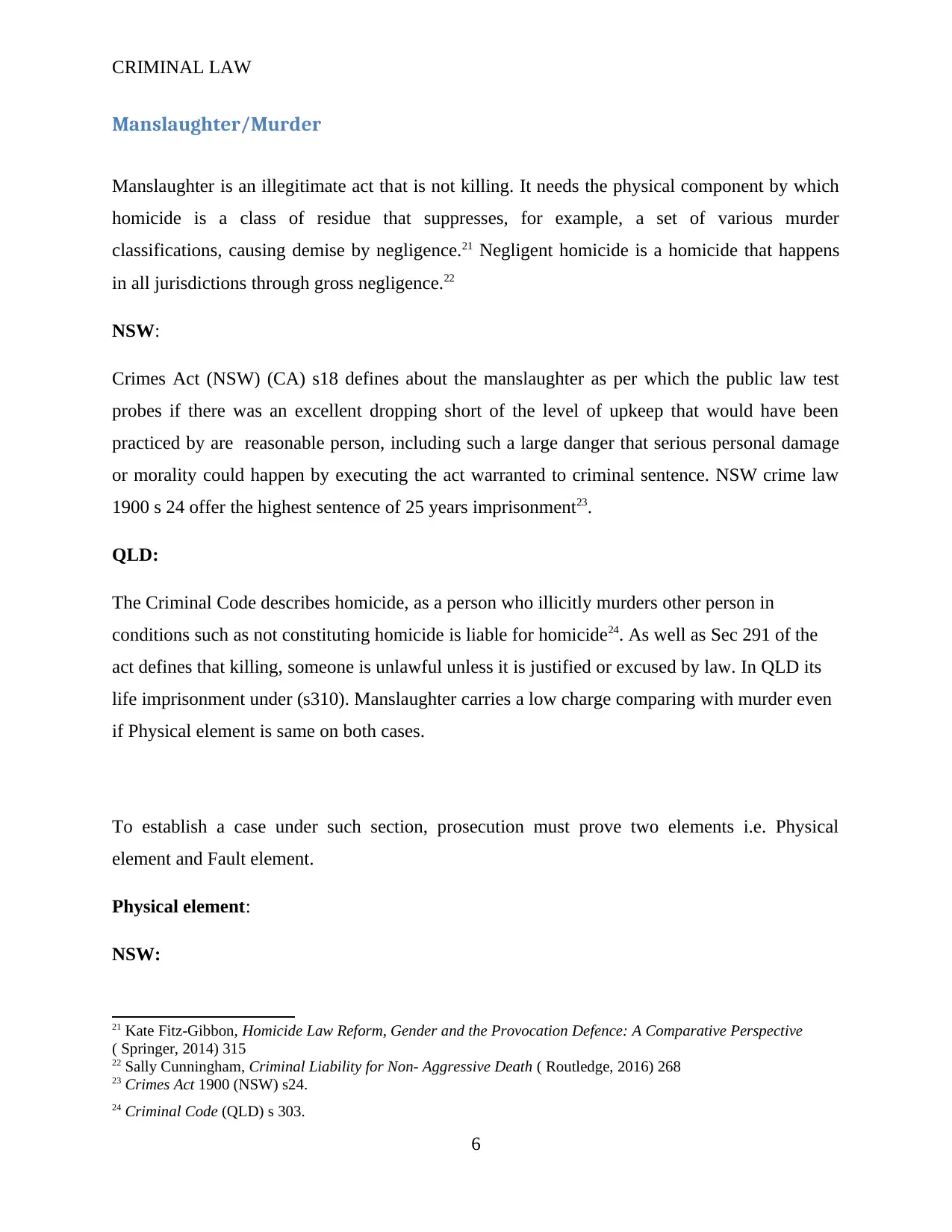
CRIMINAL LAW
Manslaughter/Murder
Manslaughter is an illegitimate act that is not killing. It needs the physical component by which
homicide is a class of residue that suppresses, for example, a set of various murder
classifications, causing demise by negligence.21 Negligent homicide is a homicide that happens
in all jurisdictions through gross negligence.22
NSW:
Crimes Act (NSW) (CA) s18 defines about the manslaughter as per which the public law test
probes if there was an excellent dropping short of the level of upkeep that would have been
practiced by are reasonable person, including such a large danger that serious personal damage
or morality could happen by executing the act warranted to criminal sentence. NSW crime law
1900 s 24 offer the highest sentence of 25 years imprisonment23.
QLD:
The Criminal Code describes homicide, as a person who illicitly murders other person in
conditions such as not constituting homicide is liable for homicide24. As well as Sec 291 of the
act defines that killing, someone is unlawful unless it is justified or excused by law. In QLD its
life imprisonment under (s310). Manslaughter carries a low charge comparing with murder even
if Physical element is same on both cases.
To establish a case under such section, prosecution must prove two elements i.e. Physical
element and Fault element.
Physical element:
NSW:
21 Kate Fitz-Gibbon, Homicide Law Reform, Gender and the Provocation Defence: A Comparative Perspective
( Springer, 2014) 315
22 Sally Cunningham, Criminal Liability for Non- Aggressive Death ( Routledge, 2016) 268
23 Crimes Act 1900 (NSW) s24.
24 Criminal Code (QLD) s 303.
6
Manslaughter/Murder
Manslaughter is an illegitimate act that is not killing. It needs the physical component by which
homicide is a class of residue that suppresses, for example, a set of various murder
classifications, causing demise by negligence.21 Negligent homicide is a homicide that happens
in all jurisdictions through gross negligence.22
NSW:
Crimes Act (NSW) (CA) s18 defines about the manslaughter as per which the public law test
probes if there was an excellent dropping short of the level of upkeep that would have been
practiced by are reasonable person, including such a large danger that serious personal damage
or morality could happen by executing the act warranted to criminal sentence. NSW crime law
1900 s 24 offer the highest sentence of 25 years imprisonment23.
QLD:
The Criminal Code describes homicide, as a person who illicitly murders other person in
conditions such as not constituting homicide is liable for homicide24. As well as Sec 291 of the
act defines that killing, someone is unlawful unless it is justified or excused by law. In QLD its
life imprisonment under (s310). Manslaughter carries a low charge comparing with murder even
if Physical element is same on both cases.
To establish a case under such section, prosecution must prove two elements i.e. Physical
element and Fault element.
Physical element:
NSW:
21 Kate Fitz-Gibbon, Homicide Law Reform, Gender and the Provocation Defence: A Comparative Perspective
( Springer, 2014) 315
22 Sally Cunningham, Criminal Liability for Non- Aggressive Death ( Routledge, 2016) 268
23 Crimes Act 1900 (NSW) s24.
24 Criminal Code (QLD) s 303.
6
Paraphrase This Document
Need a fresh take? Get an instant paraphrase of this document with our AI Paraphraser
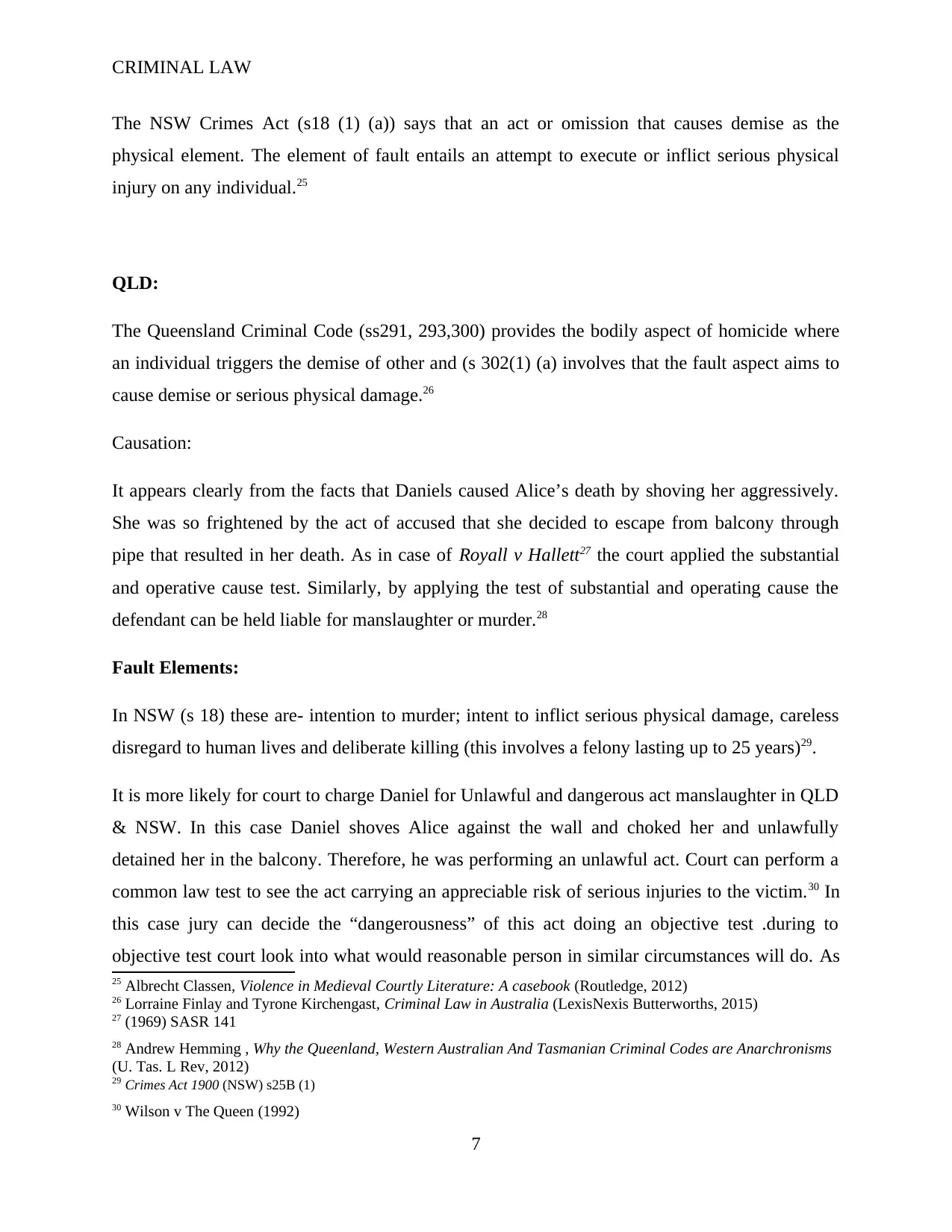
CRIMINAL LAW
The NSW Crimes Act (s18 (1) (a)) says that an act or omission that causes demise as the
physical element. The element of fault entails an attempt to execute or inflict serious physical
injury on any individual.25
QLD:
The Queensland Criminal Code (ss291, 293,300) provides the bodily aspect of homicide where
an individual triggers the demise of other and (s 302(1) (a) involves that the fault aspect aims to
cause demise or serious physical damage.26
Causation:
It appears clearly from the facts that Daniels caused Alice’s death by shoving her aggressively.
She was so frightened by the act of accused that she decided to escape from balcony through
pipe that resulted in her death. As in case of Royall v Hallett27 the court applied the substantial
and operative cause test. Similarly, by applying the test of substantial and operating cause the
defendant can be held liable for manslaughter or murder.28
Fault Elements:
In NSW (s 18) these are- intention to murder; intent to inflict serious physical damage, careless
disregard to human lives and deliberate killing (this involves a felony lasting up to 25 years)29.
It is more likely for court to charge Daniel for Unlawful and dangerous act manslaughter in QLD
& NSW. In this case Daniel shoves Alice against the wall and choked her and unlawfully
detained her in the balcony. Therefore, he was performing an unlawful act. Court can perform a
common law test to see the act carrying an appreciable risk of serious injuries to the victim.30 In
this case jury can decide the “dangerousness” of this act doing an objective test .during to
objective test court look into what would reasonable person in similar circumstances will do. As
25 Albrecht Classen, Violence in Medieval Courtly Literature: A casebook (Routledge, 2012)
26 Lorraine Finlay and Tyrone Kirchengast, Criminal Law in Australia (LexisNexis Butterworths, 2015)
27 (1969) SASR 141
28 Andrew Hemming , Why the Queenland, Western Australian And Tasmanian Criminal Codes are Anarchronisms
(U. Tas. L Rev, 2012)
29 Crimes Act 1900 (NSW) s25B (1)
30 Wilson v The Queen (1992)
7
The NSW Crimes Act (s18 (1) (a)) says that an act or omission that causes demise as the
physical element. The element of fault entails an attempt to execute or inflict serious physical
injury on any individual.25
QLD:
The Queensland Criminal Code (ss291, 293,300) provides the bodily aspect of homicide where
an individual triggers the demise of other and (s 302(1) (a) involves that the fault aspect aims to
cause demise or serious physical damage.26
Causation:
It appears clearly from the facts that Daniels caused Alice’s death by shoving her aggressively.
She was so frightened by the act of accused that she decided to escape from balcony through
pipe that resulted in her death. As in case of Royall v Hallett27 the court applied the substantial
and operative cause test. Similarly, by applying the test of substantial and operating cause the
defendant can be held liable for manslaughter or murder.28
Fault Elements:
In NSW (s 18) these are- intention to murder; intent to inflict serious physical damage, careless
disregard to human lives and deliberate killing (this involves a felony lasting up to 25 years)29.
It is more likely for court to charge Daniel for Unlawful and dangerous act manslaughter in QLD
& NSW. In this case Daniel shoves Alice against the wall and choked her and unlawfully
detained her in the balcony. Therefore, he was performing an unlawful act. Court can perform a
common law test to see the act carrying an appreciable risk of serious injuries to the victim.30 In
this case jury can decide the “dangerousness” of this act doing an objective test .during to
objective test court look into what would reasonable person in similar circumstances will do. As
25 Albrecht Classen, Violence in Medieval Courtly Literature: A casebook (Routledge, 2012)
26 Lorraine Finlay and Tyrone Kirchengast, Criminal Law in Australia (LexisNexis Butterworths, 2015)
27 (1969) SASR 141
28 Andrew Hemming , Why the Queenland, Western Australian And Tasmanian Criminal Codes are Anarchronisms
(U. Tas. L Rev, 2012)
29 Crimes Act 1900 (NSW) s25B (1)
30 Wilson v The Queen (1992)
7
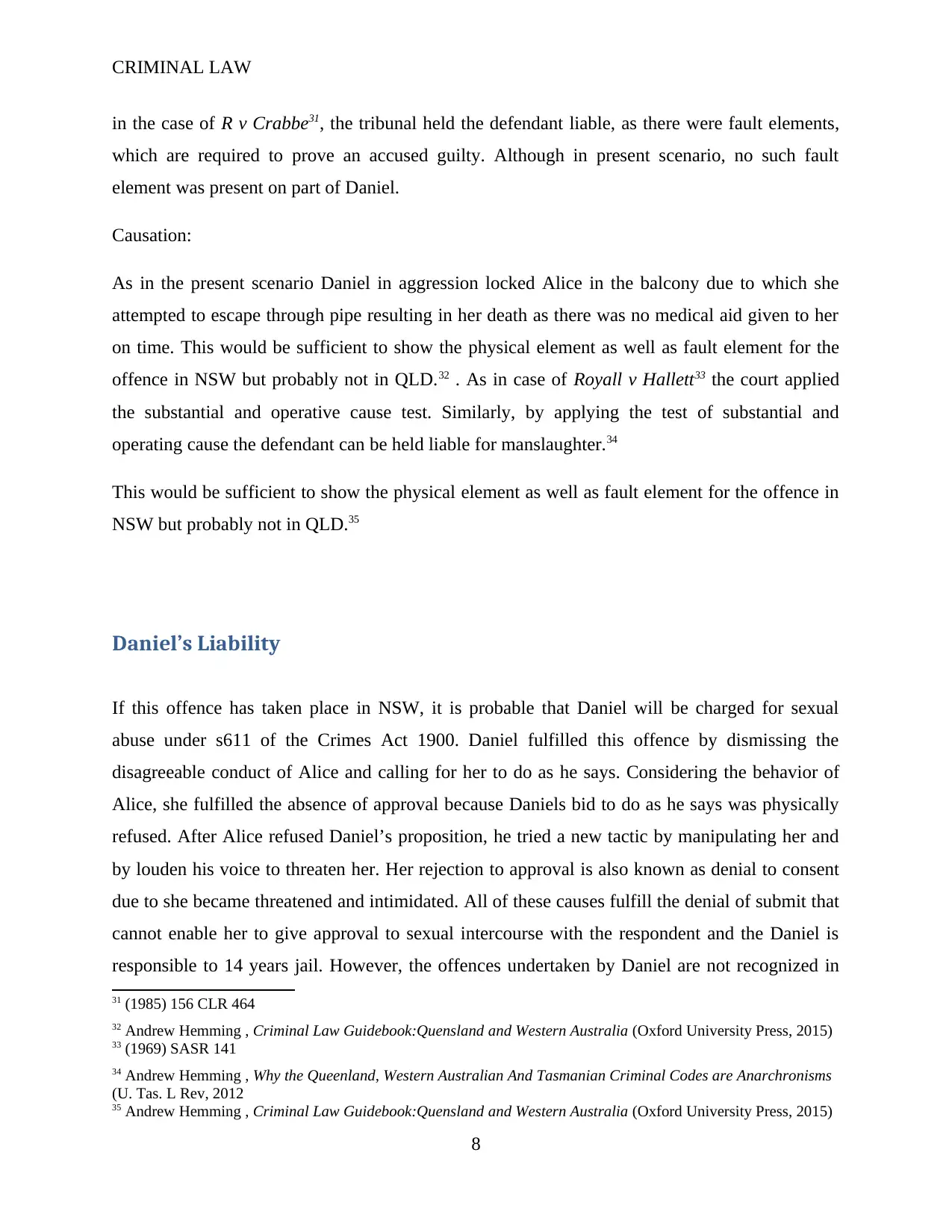
CRIMINAL LAW
in the case of R v Crabbe31, the tribunal held the defendant liable, as there were fault elements,
which are required to prove an accused guilty. Although in present scenario, no such fault
element was present on part of Daniel.
Causation:
As in the present scenario Daniel in aggression locked Alice in the balcony due to which she
attempted to escape through pipe resulting in her death as there was no medical aid given to her
on time. This would be sufficient to show the physical element as well as fault element for the
offence in NSW but probably not in QLD.32 . As in case of Royall v Hallett33 the court applied
the substantial and operative cause test. Similarly, by applying the test of substantial and
operating cause the defendant can be held liable for manslaughter.34
This would be sufficient to show the physical element as well as fault element for the offence in
NSW but probably not in QLD.35
Daniel’s Liability
If this offence has taken place in NSW, it is probable that Daniel will be charged for sexual
abuse under s611 of the Crimes Act 1900. Daniel fulfilled this offence by dismissing the
disagreeable conduct of Alice and calling for her to do as he says. Considering the behavior of
Alice, she fulfilled the absence of approval because Daniels bid to do as he says was physically
refused. After Alice refused Daniel’s proposition, he tried a new tactic by manipulating her and
by louden his voice to threaten her. Her rejection to approval is also known as denial to consent
due to she became threatened and intimidated. All of these causes fulfill the denial of submit that
cannot enable her to give approval to sexual intercourse with the respondent and the Daniel is
responsible to 14 years jail. However, the offences undertaken by Daniel are not recognized in
31 (1985) 156 CLR 464
32 Andrew Hemming , Criminal Law Guidebook:Quensland and Western Australia (Oxford University Press, 2015)
33 (1969) SASR 141
34 Andrew Hemming , Why the Queenland, Western Australian And Tasmanian Criminal Codes are Anarchronisms
(U. Tas. L Rev, 2012
35 Andrew Hemming , Criminal Law Guidebook:Quensland and Western Australia (Oxford University Press, 2015)
8
in the case of R v Crabbe31, the tribunal held the defendant liable, as there were fault elements,
which are required to prove an accused guilty. Although in present scenario, no such fault
element was present on part of Daniel.
Causation:
As in the present scenario Daniel in aggression locked Alice in the balcony due to which she
attempted to escape through pipe resulting in her death as there was no medical aid given to her
on time. This would be sufficient to show the physical element as well as fault element for the
offence in NSW but probably not in QLD.32 . As in case of Royall v Hallett33 the court applied
the substantial and operative cause test. Similarly, by applying the test of substantial and
operating cause the defendant can be held liable for manslaughter.34
This would be sufficient to show the physical element as well as fault element for the offence in
NSW but probably not in QLD.35
Daniel’s Liability
If this offence has taken place in NSW, it is probable that Daniel will be charged for sexual
abuse under s611 of the Crimes Act 1900. Daniel fulfilled this offence by dismissing the
disagreeable conduct of Alice and calling for her to do as he says. Considering the behavior of
Alice, she fulfilled the absence of approval because Daniels bid to do as he says was physically
refused. After Alice refused Daniel’s proposition, he tried a new tactic by manipulating her and
by louden his voice to threaten her. Her rejection to approval is also known as denial to consent
due to she became threatened and intimidated. All of these causes fulfill the denial of submit that
cannot enable her to give approval to sexual intercourse with the respondent and the Daniel is
responsible to 14 years jail. However, the offences undertaken by Daniel are not recognized in
31 (1985) 156 CLR 464
32 Andrew Hemming , Criminal Law Guidebook:Quensland and Western Australia (Oxford University Press, 2015)
33 (1969) SASR 141
34 Andrew Hemming , Why the Queenland, Western Australian And Tasmanian Criminal Codes are Anarchronisms
(U. Tas. L Rev, 2012
35 Andrew Hemming , Criminal Law Guidebook:Quensland and Western Australia (Oxford University Press, 2015)
8
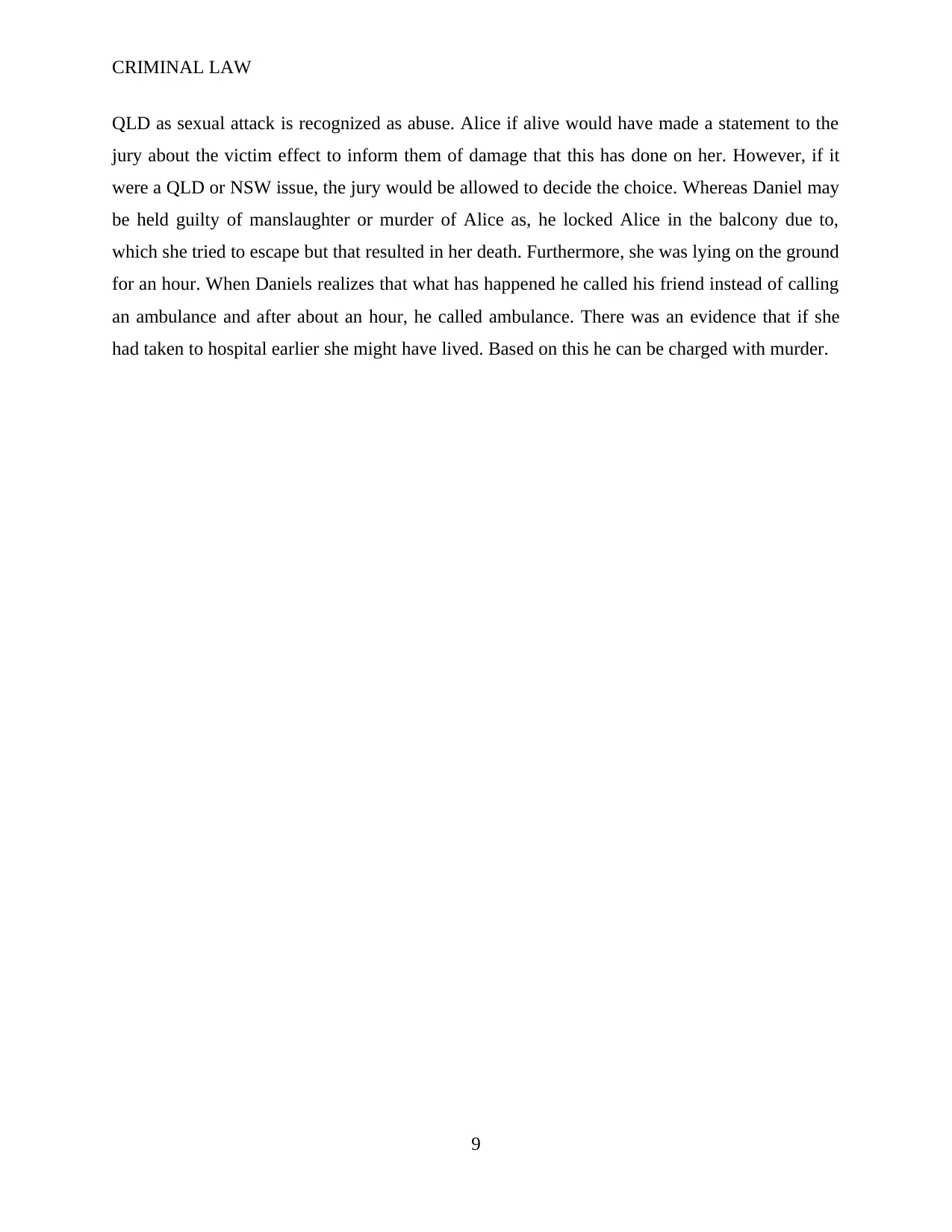
CRIMINAL LAW
QLD as sexual attack is recognized as abuse. Alice if alive would have made a statement to the
jury about the victim effect to inform them of damage that this has done on her. However, if it
were a QLD or NSW issue, the jury would be allowed to decide the choice. Whereas Daniel may
be held guilty of manslaughter or murder of Alice as, he locked Alice in the balcony due to,
which she tried to escape but that resulted in her death. Furthermore, she was lying on the ground
for an hour. When Daniels realizes that what has happened he called his friend instead of calling
an ambulance and after about an hour, he called ambulance. There was an evidence that if she
had taken to hospital earlier she might have lived. Based on this he can be charged with murder.
9
QLD as sexual attack is recognized as abuse. Alice if alive would have made a statement to the
jury about the victim effect to inform them of damage that this has done on her. However, if it
were a QLD or NSW issue, the jury would be allowed to decide the choice. Whereas Daniel may
be held guilty of manslaughter or murder of Alice as, he locked Alice in the balcony due to,
which she tried to escape but that resulted in her death. Furthermore, she was lying on the ground
for an hour. When Daniels realizes that what has happened he called his friend instead of calling
an ambulance and after about an hour, he called ambulance. There was an evidence that if she
had taken to hospital earlier she might have lived. Based on this he can be charged with murder.
9
Secure Best Marks with AI Grader
Need help grading? Try our AI Grader for instant feedback on your assignments.
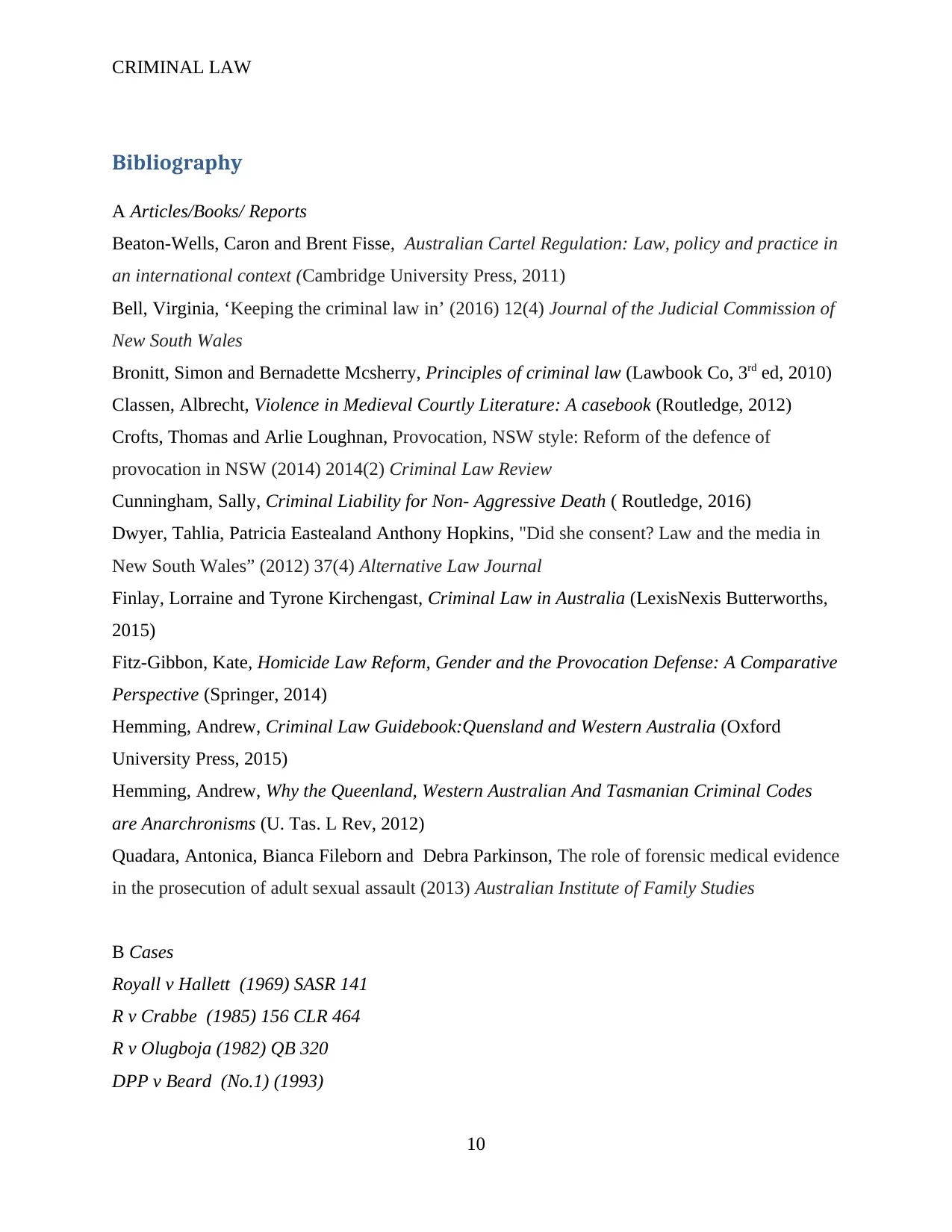
CRIMINAL LAW
Bibliography
A Articles/Books/ Reports
Beaton-Wells, Caron and Brent Fisse, Australian Cartel Regulation: Law, policy and practice in
an international context (Cambridge University Press, 2011)
Bell, Virginia, ‘Keeping the criminal law in’ (2016) 12(4) Journal of the Judicial Commission of
New South Wales
Bronitt, Simon and Bernadette Mcsherry, Principles of criminal law (Lawbook Co, 3rd ed, 2010)
Classen, Albrecht, Violence in Medieval Courtly Literature: A casebook (Routledge, 2012)
Crofts, Thomas and Arlie Loughnan, Provocation, NSW style: Reform of the defence of
provocation in NSW (2014) 2014(2) Criminal Law Review
Cunningham, Sally, Criminal Liability for Non- Aggressive Death ( Routledge, 2016)
Dwyer, Tahlia, Patricia Eastealand Anthony Hopkins, "Did she consent? Law and the media in
New South Wales” (2012) 37(4) Alternative Law Journal
Finlay, Lorraine and Tyrone Kirchengast, Criminal Law in Australia (LexisNexis Butterworths,
2015)
Fitz-Gibbon, Kate, Homicide Law Reform, Gender and the Provocation Defense: A Comparative
Perspective (Springer, 2014)
Hemming, Andrew, Criminal Law Guidebook:Quensland and Western Australia (Oxford
University Press, 2015)
Hemming, Andrew, Why the Queenland, Western Australian And Tasmanian Criminal Codes
are Anarchronisms (U. Tas. L Rev, 2012)
Quadara, Antonica, Bianca Fileborn and Debra Parkinson, The role of forensic medical evidence
in the prosecution of adult sexual assault (2013) Australian Institute of Family Studies
B Cases
Royall v Hallett (1969) SASR 141
R v Crabbe (1985) 156 CLR 464
R v Olugboja (1982) QB 320
DPP v Beard (No.1) (1993)
10
Bibliography
A Articles/Books/ Reports
Beaton-Wells, Caron and Brent Fisse, Australian Cartel Regulation: Law, policy and practice in
an international context (Cambridge University Press, 2011)
Bell, Virginia, ‘Keeping the criminal law in’ (2016) 12(4) Journal of the Judicial Commission of
New South Wales
Bronitt, Simon and Bernadette Mcsherry, Principles of criminal law (Lawbook Co, 3rd ed, 2010)
Classen, Albrecht, Violence in Medieval Courtly Literature: A casebook (Routledge, 2012)
Crofts, Thomas and Arlie Loughnan, Provocation, NSW style: Reform of the defence of
provocation in NSW (2014) 2014(2) Criminal Law Review
Cunningham, Sally, Criminal Liability for Non- Aggressive Death ( Routledge, 2016)
Dwyer, Tahlia, Patricia Eastealand Anthony Hopkins, "Did she consent? Law and the media in
New South Wales” (2012) 37(4) Alternative Law Journal
Finlay, Lorraine and Tyrone Kirchengast, Criminal Law in Australia (LexisNexis Butterworths,
2015)
Fitz-Gibbon, Kate, Homicide Law Reform, Gender and the Provocation Defense: A Comparative
Perspective (Springer, 2014)
Hemming, Andrew, Criminal Law Guidebook:Quensland and Western Australia (Oxford
University Press, 2015)
Hemming, Andrew, Why the Queenland, Western Australian And Tasmanian Criminal Codes
are Anarchronisms (U. Tas. L Rev, 2012)
Quadara, Antonica, Bianca Fileborn and Debra Parkinson, The role of forensic medical evidence
in the prosecution of adult sexual assault (2013) Australian Institute of Family Studies
B Cases
Royall v Hallett (1969) SASR 141
R v Crabbe (1985) 156 CLR 464
R v Olugboja (1982) QB 320
DPP v Beard (No.1) (1993)
10
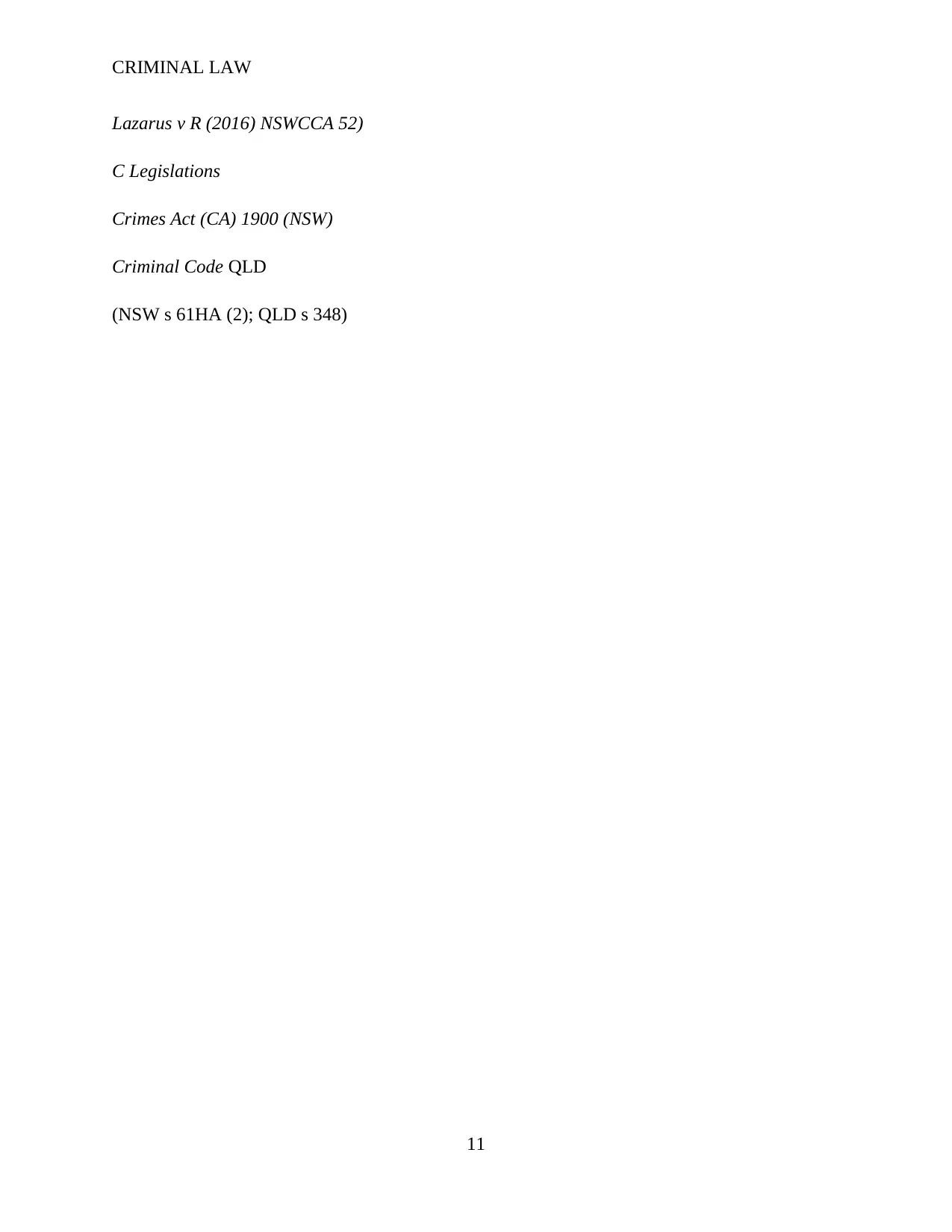
CRIMINAL LAW
Lazarus v R (2016) NSWCCA 52)
C Legislations
Crimes Act (CA) 1900 (NSW)
Criminal Code QLD
(NSW s 61HA (2); QLD s 348)
11
Lazarus v R (2016) NSWCCA 52)
C Legislations
Crimes Act (CA) 1900 (NSW)
Criminal Code QLD
(NSW s 61HA (2); QLD s 348)
11
1 out of 12
Related Documents
Your All-in-One AI-Powered Toolkit for Academic Success.
+13062052269
info@desklib.com
Available 24*7 on WhatsApp / Email
![[object Object]](/_next/static/media/star-bottom.7253800d.svg)
Unlock your academic potential
© 2024 | Zucol Services PVT LTD | All rights reserved.




